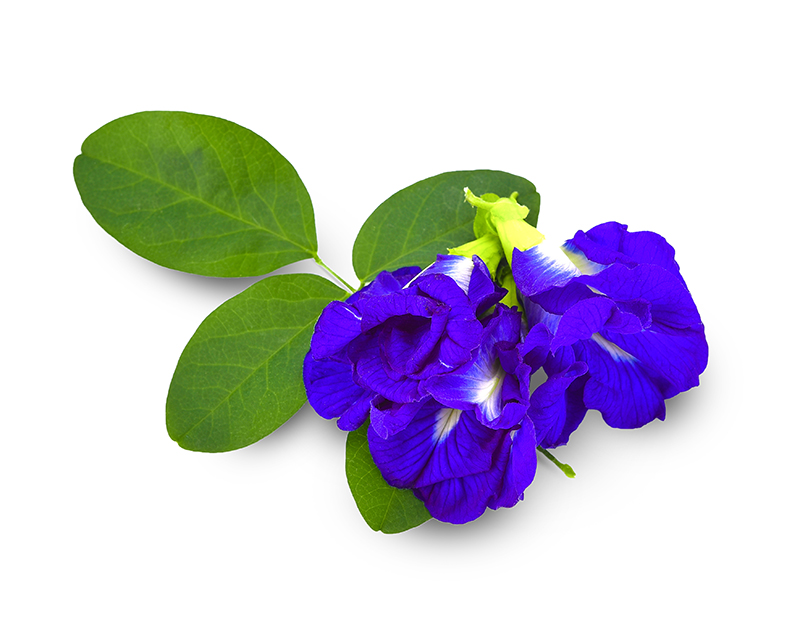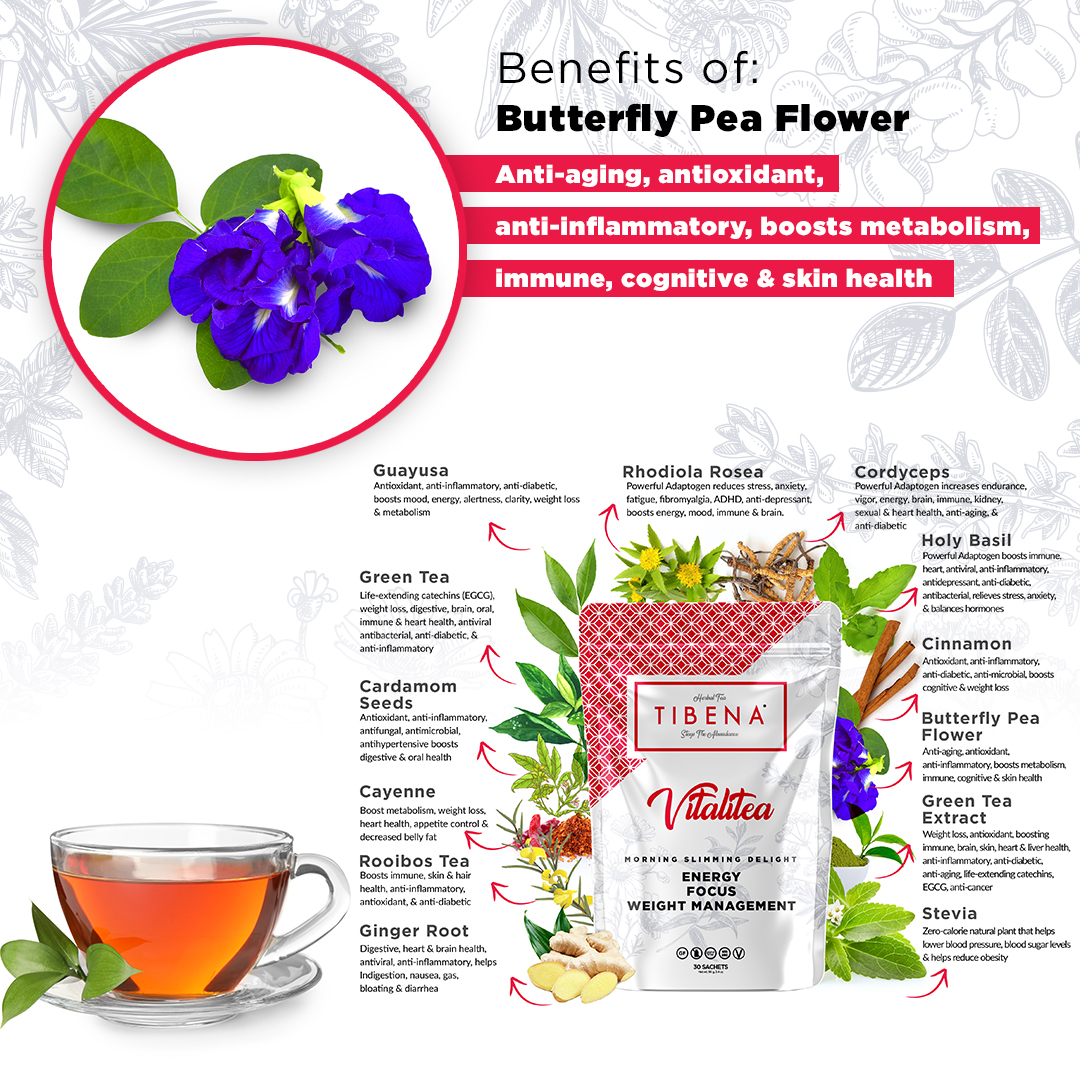
Studies have shown Potential Benefits:
Anti-aging, antioxidant, anti-inflammatory, boosts metabolism, immune, cognitive & skin health.
Butterfly Pea Flower
Dried Butterfly Pea Flower has been used for centuries in Southeast Asia to help reduce inflammation and “increase vitality.”
Butterfly Pea Flowers is bountiful in antioxidants. Due to the generous amounts of antioxidants, it’s been studied for the ability to help protect the skin from premature aging. What is interesting about this exotic tea is its ability to change colors. The secret lies in its pH level — the drink changes color depending on the pH of any ingredient that’s added to it. Its ability to change color, going from blue to a beautiful amber is none other than the butterfly pea tea.
Anti-aging, antioxidant, anti-inflammatory, boosts metabolism, immune, cognitive & skin health

https://www.ncbi.nlm.nih.gov/pmc/articles/PMC6546959/#:~:text=ternatea%20tissues.,antioxidant%2C%20and%20wound%20healing%20properties. – Comprehensive review with 148 study references of the studies that have been reported. “The extracts exhibit diuretic, nootropic, anti-asthmatic, anti-inflammatory, analgesic, antipyretic, antidiabetic, antilipidemic, anti-arthritic, antioxidant, and wound healing properties.”
https://pubmed.ncbi.nlm.nih.gov/29464849/
The traditional practice of eating the flowers of Clitoria ternatea L. or drinking their infusion as herbal tea in some of the Asian countries is believed to promote a younger skin complexion and defend against skin aging. This study was conducted to investigate the protective effect of C. ternatea flower water extract. The main compounds detected were assigned as anthocyanins derived from delphinidin, including polyacylated ternatins, and flavonol glycosides derived from quercetin and kaempferol. These results demonstrated the protective effects of C. ternatea flower extracts that contain polyacylated anthocyanins and flavonol glycosides as major constituents, against H2 O2 and UV-induced oxidative stress on skin cells, and may provide some explanation for the putative traditional and cosmetic uses of C. ternatea flower against skin aging.
http://www.iosrphr.org/papers/v6i3/G0636883.pdf – Pharmacological review of Butterfly Pea flower (clitoria ternatea) along with 131 study references showing a wide range of pharmacological activities including antimicrobial, antiparastic, antioxidant, anticancer, hypolipidemic, cardiovascular, central nervous, brain health, respiratory,antiasmatic, gastrointestinal, immunological, anti-inflammatory, analgesic antipyretic and many other pharmacological effects.
https://pubmed.ncbi.nlm.nih.gov/18926895/ – Clitoria ternatea L. (CT) (Family: Fabaceae) commonly known as ‘Butterfly pea’, a traditional Ayurvedic medicine, has been used for centuries as a memory enhancer, nootropic, antistress, anxiolytic, antidepressant, anticonvulsant, tranquilizing and sedative agent. A wide range of secondary metabolites including triterpenoids, flavonol glycosides, anthocyanins and steroids has been isolated from Clitoria ternatea Linn. Its extracts possess a wide range of pharmacological activities including antimicrobial, antipyretic, anti-inflammatory, analgesic, diuretic, local anesthetic, antidiabetic, insecticidal, blood platelet aggregation-inhibiting and for use as a vascular smooth muscle relaxing properties. This plant has a long use in traditional Ayurvedic medicine for several diseases and the scientific studies has reconfirmed those with modern relevance.
https://pubmed.ncbi.nlm.nih.gov/12895670/ – The present investigation was aimed at determining the spectrum of activity of the methanolic extract of Clitoria ternatea (CT & known as Butterfly Pea) on the Central Nervous System. In conclusion, the extract was found to possess nootropic, anxiolytic (reduce anxiety), antidepressant, anticonvulsant and anti-stress activity.
https://www.ncbi.nlm.nih.gov/pmc/articles/PMC5759795/ – this study showed that consuming Butterfly pea or (Clitoria Ternatea it increases plasma antioxidant capacity without hypoglycemia in the fasting state. It also improves postprandial glucose, insulin and antioxidant status when consumed with sucrose. The study was an excellent indicatory how such simple food-based (herbal) interventions may be used in our war against diabetes.
Indian Ayurvedic Medicine in Aging & Prevention Treatment”, In tests the Butterfly Pea (Clitoeria Ternatea) is known and proven to promote intelligence and cognitive function.
https://www.researchgate.net/publication/325183019_A_potential_of_Telang_tree_Clitoria_ternatea_in_human_health – The potential in human health – antioxidant, anti-diabetic, anti-microbial, analgesic (reduce pain), antipyretic (reduce fever), anti-microbial, anti-parasitic, hepatoprotective (liver health) anti-asthmatic, neuropharmacological activity (improving cognitive behavior)
The value of mankind is inextricably linked with the wellbeing through natural resources
specially the plants around him. Medicinal plants are gift of God, to cure innite number
of diseases in human beings and other living organism. These Plant materials have been
extensively used in the indigenous system of medicine which is mention in the Ayurveda
and other Indian literature. In all ancient scriptures of Ayurveda, Aparajita is mentioned
as one of the important herb. It is a good looking twing herb and very common garden
ower plant found all over India especially in southern India Aparajita’s botanical name
is Clitoria ternatea and belongs to Fabaceae (Pipilionaceae) family. C. ternatea is a garden
plant of India, which has been used the traditional and folkloric medicine in the various
diseases. It is scientically evaluated for anti-inammatory, antipyretic, analgesic, larvicidal,
insecticidal, antimicrobial, anxiolytic, antidepressant, hepatoprotective, tranquilizing
and sedative property. This paper reviews plant distribution, agronomic characteristics,
pharmacognostical description, ornamental value, traditional properties and uses, phyto-
contituents, pharmacological activity of buttery pea. Thus, the present study is an effort to
compile a detailed account and literature survey of Clitoria ternatea plant.
https://www.ncbi.nlm.nih.gov/pmc/articles/PMC5903984/ – Studies suggest that compounds within butterfly pea flower tea have an inhibitory effect on alpha-amylase. What is alpha-amylase? Alpha-amylase is an enzyme secreted by the pancreas into the small intestine (and also found in saliva) that breaks starch down into glucose. As a result, the tea could potentially slow the digestion of carbohydrate, thus lowering the glycemic response to a carbohydrate-rich meal. Resulting in a benefical impact on blood sugar levels & regulation.
https://www.hindawi.com/journals/ecam/2019/2916914/
Butterfly Pea Flower possesses antioxidant properties via multiple mechanisms, used as a functional natural beverage to manage oxidative stress associated with chronic diseases.
https://www.sciencedirect.com/science/article/abs/pii/S0378874108004911?via%3Dihub – Indepth review
